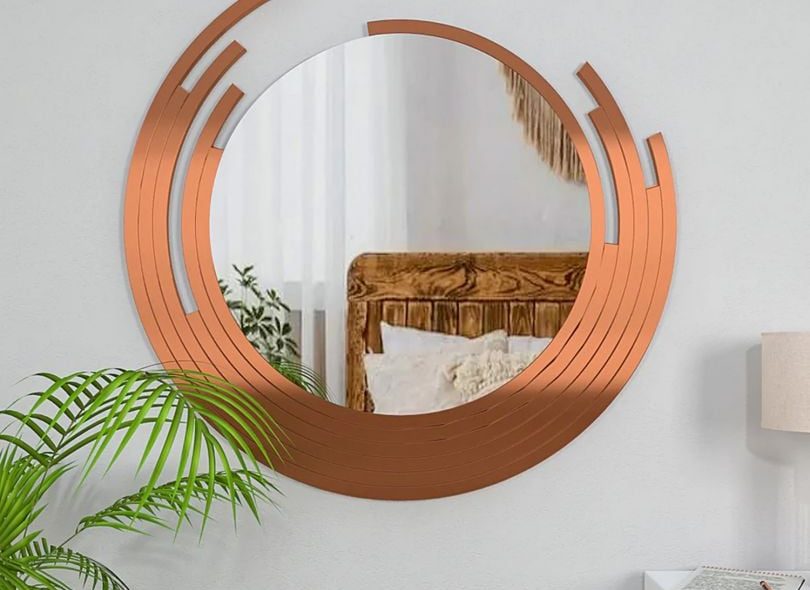Decorating a small space can feel like a challenge, but with the right tricks, even the tiniest room can appear bright, open, and inviting. One of the most powerful and affordable tools for visually expanding a room is a wall mirror. When used strategically, mirrors can completely transform your space, adding light, depth, and dimension. In this article, we’ll guide you through expert tips and creative ideas on how to make a small room look bigger with a wall mirror.
Why Wall Mirrors Work So Well in Small Spaces
Before diving into placement and styling, it’s important to understand why mirrors are so effective in interior design—especially in small rooms.
1. They Reflect Light
Mirrors bounce both natural and artificial light across a room. This creates the illusion of brightness and openness, making the space feel less cramped. The more light you reflect, the airier your room will appear.
2. They Add Depth
A mirror can act like a “window,” giving the illusion that the room continues beyond the wall. This sense of extra space adds dimension and can trick the eye into thinking the room is larger than it actually is.
3. They Create Visual Interest
Beyond their functional benefits, mirrors can serve as stunning decor pieces. A stylish mirror becomes an instant focal point, drawing attention and giving your space a polished, thoughtfully designed feel.
Best Practices for Using Wall Mirrors to Enlarge a Room
Now that you know why mirrors are effective, let’s talk about how to use them strategically in your space.
1. Place Mirrors Opposite Windows
This is one of the most effective placements. A mirror placed opposite a window reflects the outside view and light, doubling the visual space and brightness. This technique can make even a windowless corner feel more lively and open.
Tip: Choose a mirror that’s nearly as tall as the window for maximum effect.
2. Use Large Mirrors for Maximum Impact
When trying to make a room feel bigger, size matters. A large wall mirror, or a full-length mirror mounted horizontally, can dramatically widen the visual field. It reflects more of the room and adds significant depth.
Pro idea: Place a large mirror behind furniture, like a sofa or console table, to make the setup feel more expansive.
3. Try Mirrored Walls or Panels
If you’re really committed to the illusion of space, consider installing a mirrored wall or using mirrored panels. These work particularly well in narrow areas like hallways or small dining rooms, where they can effectively double the perceived space.
However, avoid overdoing it—too many mirrors can feel disorienting or overwhelming.
Mirror Styles That Work Best for Small Rooms
Wall mirrors come in a wide range of shapes, frames, and styles. Here are a few types that can enhance a small room:
1. Frameless Mirrors
Sleek and minimalist, frameless mirrors blend seamlessly with your wall and maximize the feeling of openness. They’re perfect for contemporary or modern interiors.
2. Round Mirrors
Round mirrors can soften the sharp angles of a small room and add a balanced, artistic touch. They’re ideal above a fireplace, a small console table, or in entryways.
3. Arched or Windowpane Mirrors
These mimic the look of a real window and are excellent for visually opening up enclosed spaces. Try placing one in a hallway or behind a reading nook.
4. Antique or Decorative Frames
Incorporating a mirror with a beautifully carved or vintage frame can add charm and elegance to the room. Choose lighter-colored or metallic frames to keep the look airy.
Tips for Specific Rooms
Each room has different needs. Here’s how you can tailor your mirror placement and style for different small spaces:
Living Room
- Hang a large horizontal mirror behind the sofa to elongate the wall.
- Use a tall mirror in a corner to reflect both natural light and artwork or plants.
Bedroom
- Place a mirror above the headboard or opposite the bed to reflect light and décor.
- Use mirrored wardrobe doors or a full-length mirror near a vanity.
Dining Room
- A mirror on one of the longer walls can double the feeling of space and make meals feel more elegant.
- Reflecting a chandelier or pendant light with a mirror enhances the ambiance.
Hallway or Entryway
- Use vertical mirrors to stretch the space upward and create a welcoming look.
- Round mirrors above a console table create a cozy, styled vignette that also opens up the space.
Common Mistakes to Avoid
Even though mirrors are a powerful tool, they should be used with intention. Here are some pitfalls to watch out for:
1. Reflecting Clutter
Mirrors double what they reflect. If your mirror is facing a messy shelf or an unflattering view, it can amplify the clutter rather than enhance the room.
2. Poor Placement
A mirror placed too high or too low disrupts the visual flow. Eye-level placement generally works best, unless it’s specifically part of an artistic arrangement.
3. Too Many Mirrors
While it’s tempting to fill every wall with mirrors, it can quickly turn your space into a funhouse. Stick to one or two large mirrors, or group smaller ones carefully to avoid overwhelming the room.
Final Thoughts
If you’re trying to make a small room feel larger, a Wall Mirror is one of the easiest and most effective design tricks at your disposal. With thoughtful placement and the right style, mirrors can reflect light, add depth, and elevate your space beautifully. Whether you’re in a studio apartment, a compact bedroom, or a cozy living area, don’t underestimate what a well-placed mirror can do.
So next time you feel boxed in by four small walls, let a mirror open things up—because sometimes, the best way to go big is by reflecting smart.

